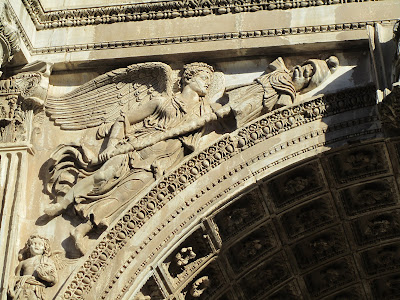 |
| Detail of the Arch of Septimius Severus, Roman Forum |
The reason I'm posting this photo is because of the Phrygian cap on the figure (or figurehead) on the right. I was photographing interesting bits in the Forum in Rome when I looked up and said, "Hey, that's the French Revolution hat!" I've always thought these were spunky little caps, all lefty and revolutionarily cool because worn by French revolutionaries, as depicted in Delacroix's famous
Liberty Leading the People:
 |
| You can see the Phrygian cap on Liberty herself |
During the French Revolution, the Phrygian cap symbolized liberty, and so was the headgear in hottest demand in revolutionary circles. I suspect Mme Defarge* knitted her share of Phrygian caps.
I didn't realize that the Phrygian cap also had special meaning in Classical Greece and Rome, but the
Wikipedia enlightened me. To Greeks, the cap, which was originally worn by—go figure—Phyrigians**, denoted a non-Greek, and thus, symbolically, an outsider. To Romans, the cap denoted a free man, which eventually led to its symbolic identification with liberty, and thus to its being a hot commodity in the 1790s.
I thought it would be fun to include a knitting pattern for a Phrygian cap, and the first thing I found when I went looking for a pattern was a blog
post from a woman who is—delicious irony here—knitting Phrygian caps for people at Occupy D.C. She includes her knitting pattern if you want to try. I think red is the obvious color choice.
*Who's Mme Defarge? Drop everything and go get yourself a copy of Dickens's
A Tale of Two Cities. You will meet Mme Defarge. You will never again look at someone knitting without getting a
frisson of dread. Go. Read. Now.
**Phrygians were from central Anatolia (modern-day Turkey and environs).














